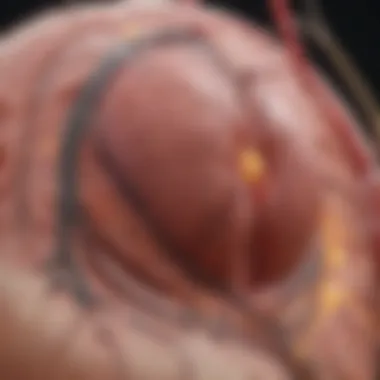Coronary Ablation: Techniques, Indications, and Outcomes


Overview of Research Topic
Brief Background and Context
Coronary ablation is an increasingly relevant procedure in the realm of cardiology, primarily aimed at correcting arrhythmias. Arrhythmias, or irregular heart beats, can lead to serious complications, including strokes and heart failure. Traditionally, antiarrhythmic medications were the primary line of treatment. However, these often come with significant side effects. As a result, the need for effective, less invasive procedures has driven the development of coronary ablation techniques.
Understanding the nuances of this procedure is crucial for both medical professionals and patients alike. Its acceptance and implementation mark a substantial shift in how arrhythmias are managed, providing options that are often more effective than traditional therapeutic methods.
Importance in Current Scientific Landscape
The importance of coronary ablation in contemporary cardiology cannot be understated. New technologies and improved techniques have made the procedure safer and more effective. By precisely targeting cardiac tissues responsible for arrhythmias, coronary ablation minimizes damage to surrounding healthy tissue, leading to better outcomes and fewer post-operative complications. The integration of advanced imaging techniques enhances the physician's ability to visualize and navigate the heart anatomy. As ongoing research explores the long-term impacts of coronary ablation, its role will only continue to evolve.
Methodology
Research Design and Approach
This article employs a comprehensive research design that synthesizes current literature and expert opinions on coronary ablation. By examining peer-reviewed studies, clinical trials, and expert reviews, a clearer picture of the procedure's effectiveness and scope is established. These sources provide insights into various methodologies of coronary ablation, including the technologies involved, the types of arrhythmias addressed, and the outcomes recorded post-procedure.
Data Collection Techniques
The data for this exploration is collected from reputable medical journals, clinical databases, and professional cardiology associations. Articles sourced cover various aspects of coronary ablation, including procedural details, success rates, and patient outcomes. Additionally, anecdotal evidence and case studies are employed to highlight the practical applications of this significant cardiac intervention.
"Coronary ablation offers a promising alternative to traditional medications, with a growing body of evidence supporting its efficacy."
Through this thorough methodology, the article aims to provide a solid framework for understanding coronary ablation, solidifying its essential place in modern cardiac care.
Prologue to Coronary Ablation
Coronary ablation is a pivotal technique in the field of cardiology, primarily aimed at addressing arrhythmias through targeted destruction of aberrant cardiac tissue. Understanding this procedure is essential, as it holds substantial implications for patient management and treatment outcomes in various heart conditions.
Definition and Relevance
Coronary ablation refers to a medical procedure where heat or cold energy is used to destroy small areas of heart tissue that may be causing abnormal electrical signals. This intervention is especially relevant in the management of conditions like atrial fibrillation, ventricular tachycardia, and other arrhythmias that do not respond well to traditional medical therapies. The relevance is underscored by the fact that arrhythmias can lead to severe complications, including stroke and heart failure, thereby making timely and effective treatment crucial.
The significance of coronary ablation lies in its ability to restore normal heart rhythm, allowing patients to enjoy improved quality of life. In recent years, the technique has evolved, incorporating advanced technologies that enhance precision and efficacy, such as three-dimensional mapping and robotic assistance. These developments signify not only an advancement in treatment options but also a potential reduction in procedural risks.
Historical Context
The journey of coronary ablation began in the late 20th century when initial studies demonstrated the possibility of using thermal energy to treat cardiac arrhythmias. This marked a significant shift in the treatment landscape, from pharmacological therapies to more targeted interventions. Over time, with the accumulation of clinical data and advancements in technology, coronary ablation gained acceptance as a first-line treatment for certain arrhythmias.
In the early 2000s, radiofrequency ablation emerged as a dominant technique, providing reliable results and expanding its use. The introduction of cryoablation further diversified treatment options, offering alternatives for patients with specific needs or procedural risks. The development of guidelines by various cardiology associations has also helped standardize the practice, thus enhancing patient safety and outcomes.
As research continues to explore the efficacy of different ablation techniques, the historical evolution of coronary ablation not only underscores its relevance but also reflects the ongoing commitment of the medical community to optimize care for patients with arrhythmias.
Physiology of the Heart and Arrhythmias
Understanding the physiology of the heart and the mechanisms of arrhythmias is crucial in the context of coronary ablation. This knowledge forms the foundation for identifying the specific cardiac tissues that need to be targeted during an ablation procedure. Comprehending how the heart functions and how its electrical system develops irregularities is essential for physicians and researchers alike. This section delves into basic cardiac anatomy and the specific mechanisms that lead to arrhythmias, explaining their importance in the evaluation and treatment approaches in cardiology.
Basic Cardiac Anatomy
The heart is an intricate organ with a complex structure that facilitates its primary function: pumping blood throughout the body. The heart is divided into four chambers: the right atrium and right ventricle, as well as the left atrium and left ventricle. Blood flow follows a specific pathway:
- Right Atrium: Receives deoxygenated blood from the body.
- Right Ventricle: Pumps blood to the lungs for oxygenation.
- Left Atrium: Receives oxygenated blood from the lungs.
- Left Ventricle: Pumps oxygen-rich blood to the rest of the body.
Additionally, several important components work together to regulate the heart's rhythm and ensure efficient blood flow. The sinoatrial (SA) node, often referred to as the heart's natural pacemaker, initiates electrical impulses that dictate the heartbeat. These impulses travel through specialized conductive pathways, including the atrioventricular (AV) node, Bundle of His, and Purkinje fibers. An understanding of these components and their functions is particularly vital when considering the occurrence of arrhythmias.
Mechanisms of Arrhythmia
Arrhythmias arise when there is a disruption in the normal electrical signaling within the heart. Various factors can contribute to this irregularity, leading to either too fast, too slow, or erratic heartbeats. The mechanisms behind arrhythmias are diverse and include:
- Reentry Circuits: This occurs when an impulse circles back on itself, creating a continuous electrical signal. Reentry can lead to conditions such as atrial flutter or ventricular tachycardia.
- Automaticity: Abnormal automaticity refers to pacemaker cells outside of the SA node initiating impulses, potentially causing ectopic beats.
- Triggered Activity: This can happen when afterdepolarizations occur—abnormal impulses that follow a normal cardiac action potential can trigger further impulses, leading to tachycardia.
Understanding these mechanisms is essential for targeting appropriate treatment strategies, including coronary ablation. By ablating tissue at specific sites known to generate errant electrical impulses, physicians can restore normal rhythm, offering substantial benefits for affected individuals.
"Understanding the underlying mechanisms of arrhythmias not only aids in diagnosis but also informs the therapeutic approach in coronary ablation."
Thorough knowledge of cardiac anatomy and arrhythmia mechanisms is vital in maximizing the effectiveness of coronary ablation. This knowledge directly contributes to patient selection and successful outcomes during possible interventional procedures.
Types of Coronary Ablation Methods
Understanding the variety of coronary ablation methods available is essential for several reasons. Each technique has distinct mechanisms, advantages, and indications. Knowledge of these methods facilitates an informed discussion between healthcare professionals and patients regarding treatment options for arrhythmias. Additionally, recognizing the nuances of these techniques helps in optimizing patient outcomes and may influence the selection process. Ultimately, the types of coronary ablation methods employed can greatly affect the success rate and recovery times for individuals undergoing treatment.
Radiofrequency Ablation
Radiofrequency ablation (RFA) is one of the most commonly used techniques for treating arrhythmias. This method utilizes high-frequency electrical energy to create heat, which then destroys abnormal heart tissue responsible for triggering erratic electrical signals. The precision of RFA allows for a targeted approach, minimizing damage to surrounding healthy tissues.
One of the significant benefits of RFA is its effectiveness in treating conditions like atrial fibrillation and ventricular tachycardia. It has been shown to significantly reduce symptoms and improve the quality of life for many patients. However, practitioners must consider that factors such as the patient's overall health, the type of arrhythmia, and the size of the area needing treatment can influence the decision to use RFA.
Cryoablation
Cryoablation is another strategic method that leverages extreme cold to ablate cardiac tissues. Using a liquid nitrogen-based catheter, this technique freezes the targeted area, interrupting the conduction pathways that lead to arrhythmias. Cryoablation is particularly beneficial during procedures involving delicate anatomical structures since it reduces the risk of collateral damage often seen in thermal approaches.
The effectiveness of cryoablation has been highlighted for specific types of arrhythmias, such as atrial flutter. Its ability to ice tissues can often lead to a rapid recovery time. However, clinicians must weigh this method against individual patient traits, as not all patients are suitable candidates for cryoablation.
Laser Ablation


Laser ablation is a relatively newer technique compared to RFA and cryoablation. In this process, laser light is used to precisely target abnormal cardiac tissues with minimal invasiveness. The laser creates vaporization of tissues, effectively mitigating the area causing an arrhythmia. One advantage of laser ablation lies in its incredible accuracy. This method is particularly useful in regions that are challenging to access with conventional techniques.
While it shows promise, laser ablation is not widely adapted across all facilities due to the need for specialized equipment and training. Also, long-term outcome data for this technique is still accumulating, which adds a layer of uncertainty for both patients and providers.
Other Emerging Techniques
The field of cardiac ablation continues to evolve, with various emerging techniques gaining traction. Techniques such as pulsed-field ablation utilize non-thermal energy to create lesions in the cardiac tissue. This method aims to minimize injury to adjacent tissues while achieving the desired ablation effects. Emerging technologies also explore the integration of 3D mapping systems to improve procedural accuracy and reduce potential complications.
As these methods advance, they bring potential benefits and some uncertainties. Ongoing research in this area will likely provide greater insight into their safety and efficacy as the cardiac community seeks more precise ways to manage arrhythmias.
Indications for Coronary Ablation
Coronary ablation serves a critical role in the treatment of various cardiac arrhythmias, each presenting unique challenges and patient needs. Understanding the indications for this procedure is vital, as it guides clinical decision-making and optimizes patient outcomes. This section will delve into the specific arrhythmias most commonly treated with ablation techniques, providing detailed insights into the conditions that necessitate this intervention. A careful examination of indications helps highlight its potential benefits as well as important considerations.
Atrial Fibrillation
Atrial fibrillation (AF) is the most common arrhythmia encountered in clinical practice and significantly impacts morbidity and mortality. The condition is characterized by irregular and often rapid heart rhythm. Patients with AF are at a heightened risk for stroke and heart failure. Catheter ablation is often indicated when pharmacological management fails to control symptoms or when patients have significant side effects from medication.
In patients with symptomatic AF, microwave and radiofrequency ablation techniques are frequently employed. Studies show that these procedures can lead to improved symptoms and reduced hospitalizations due to cardiac events. Furthermore, AF ablation can diminish the risk of stroke when it restores normal sinus rhythm. However, each patient must be carefully assessed for risks.
Ventricular Tachycardia
Ventricular tachycardia (VT) is a more concerning arrhythmia that arises from the ventricles. It can lead to severe complications, including syncope, cardiac arrest, or sudden cardiac death. The indications for ablation in patients with VT include those who are symptomatic despite medical therapy or have a history of ventricular fibrillation.
Ablation in VT is often more complex given its origins in myocardial scars or structural heart disease. The success rate varies based on the underlying cause and patient comorbidities. Nevertheless, studies suggest that catheter ablation may significantly reduce the burden of arrhythmia and improve overall survival rates. Careful patient selection remains paramount.
Supraventricular Tachycardia
Supraventricular tachycardia (SVT) encompasses various arrhythmias that originate above the ventricles. It is often characterized by episodes of rapid heart rates due to abnormal electrical circuit pathways within the heart. SVT may include conditions like atrial flutter and atrioventricular nodal reentrant tachycardia.
Indications for ablation in SVT patients typically arise when episodes are frequent, symptomatic, or not manageable with lifestyle changes or medication. Catheter ablation is generally a highly effective treatment for SVT, offering the possibility of a curative approach by targeting and disrupting the abnormal electrical pathways. The success rate of ablations in SVT is usually high, with long-term freedom from symptoms reported in a significant number of cases.
Conclusion: Understanding the vital indications for coronary ablation not only enhances effective clinical decision-making but also improves patient care. Managing arrhythmias like atrial fibrillation, ventricular tachycardia, and supraventricular tachycardia with ablation provides patients with options that may lead to better long-term health outcomes.
Pre-Abaltion Assessment
Pre-ablation assessment is a crucial step in the management of patients who may undergo coronary ablation. This phase is not merely a formality; it lays the foundation for a successful procedure, aligning the patient's condition with the appropriate intervention. A thorough assessment can help mitigate risks, tailor treatment plans, and enhance overall patient outcomes.
Patient Selection Criteria
Evaluating patient selection criteria involves a multifaceted approach. Clinicians must consider various factors when determining whether a patient is suitable for coronary ablation. Key factors include:
- Type of Arrhythmia: Not all arrhythmias respond equally well to ablation. Conditions like atrial fibrillation and ventricular tachycardia have specific guidelines for ablation therapy.
- Severity of Symptoms: Patients with debilitating symptoms often benefit most from the procedure. It is essential to assess how significantly the arrhythmia affects quality of life.
- Previous Treatments: Documenting any prior treatments such as medications or other interventions provides insight into the patient's history and potential efficacy of ablation.
- Comorbid Conditions: Understanding additional health issues, such as heart failure or other cardiovascular diseases, ensures a comprehensive view of the patient’s health.
This careful assessment process is vital. It not only identifies those who will likely benefit but also helps to avoid unnecessary intervention for those whose conditions may be managed through less invasive means.
Diagnostic Testing
Diagnostic testing complements the selection criteria by providing objective data that informs the decision-making process. Several tests may be utilized:
- Electrophysiological Studies (EPS): This test evaluates the electrical activity in the heart, pinpointing the origin of arrhythmias.
- Holter Monitoring: Extended monitoring records the heart's rhythm over 24 hours, capturing intermittent arrhythmias that may not show up during a standard ECG.
- Echocardiography: This imaging technique assesses the heart's structure and function, giving vital insights into any underlying conditions that may influence treatment.
Overall, thorough pre-ablation assessment allows for an informed approach to intervention. It protects patient safety and aligns treatment strategies with individual patient profiles, ultimately leading to better recovery and long-term results.
"Understanding the pre-ablation process is as critical as the procedure itself. It enhances precision and outcomes in arrhythmia management."
In closing, the details captured during these assessments significantly inform clinicians about potential risks and expected outcomes, ensuring that coronary ablation is both effective and safe.
The Ablation Procedure
The ablation procedure is a critical intervention in the treatment of arrhythmias. Understanding this process is paramount for both practitioners and patients. It involves the targeted destruction of specific areas of heart tissue that are responsible for causing abnormal heart rhythms. The goal is to restore normal electrical conduction in the heart, thus improving overall cardiac function and quality of life.
The importance of this procedure can be highlighted through several key points:
- Targeted Treatment: The procedure is precise, allowing for ablation of only the troublesome tissue while sparing surrounding areas.
- Reduced Symptoms: Patients often experience fewer symptoms post-procedure, such as palpitations or chest pain.
- Potential for Cure: In some cases, the procedure can lead to a complete cure of arrhythmic episodes.
In essence, the ablation procedure represents a convergence of technology and cardiology, where advancements enable better outcomes for patients.
Preparation and Anesthesia
Proper preparation is crucial for the success of the ablation procedure. This stage typically involves a thorough assessment of the patient's overall health and heart condition. Several instructions might involve both the clinician and the patient:
- Medical History Review: A complete review of the patient's medical history is necessary to identify any contraindications.
- Medication Adjustment: Patients are usually advised to stop certain medications before the procedure, particularly anticoagulants or antiarrhythmics, to minimize bleeding and drug interactions.
- Fasting: Patients may be required to fast for several hours before the procedure to reduce the risk of complications during anesthesia.
Anesthesia plays an important role in patient comfort. Most commonly, a combination of sedation and local anesthesia is used. This approach allows for minimal discomfort while ensuring the patient remains calm. In more complex cases, general anesthesia might be considered for the patient's safety and comfort.
Step-by-Step Procedure
The ablation procedure can be intricate but can be broken down into a few understandable steps:
- Vascular Access: The procedure typically begins with the insertion of catheters through the femoral vein in the groin. Imaging techniques guide their positioning in the heart.
- Mapping of Electrical Activity: Electrophysiological mapping is performed to identify abnormal electrical pathways. This step is essential for determining the precise locations that need ablation.
- Ablation: Using either radiofrequency energy or cryoablation, the targeted tissue is destroyed. The method used depends on the type of arrhythmia and the individual patient's condition.
- Observation: After the ablation, the heart is monitored to evaluate immediate effects. The medical team will check for any signs of complications or arrhythmias.
- Recovery: Once the procedure is complete, the patient will recover, usually in a supervised unit where constant monitoring occurs.
In summary, the ablation procedure is a multifaceted process that requires careful planning and execution. The skills of the medical team and the technological capabilities available significantly influence the outcomes.
"Understanding the ablation procedure allows healthcare providers to make informed decisions, ensuring that patients receive optimal treatment."


By elucidating the details of the preparation, anesthesia, and the step-by-step approach, both professionals and patients can gain a clearer perspective on this vital cardiac intervention.
Post-Ablation Care
Post-ablation care is a crucial aspect of the coronary ablation process. After undergoing the ablation procedure, it is essential to ensure that the patient returns to a stable state and has the requisite support during their recovery. Understanding the need for close supervision, effective pain management, and patient education becomes paramount. This phase significantly influences outcomes and can help minimize risks.
Monitoring and Recovery
During the initial recovery, monitoring plays a prominent role. Healthcare providers closely assess the patient’s vital signs, including heart rate and rhythm, blood pressure, as well as oxygen saturation levels. Continuous ECG monitoring is often employed to identify any arrhythmias or complications early on.
Recovery protocols typically involve:
- Bed Rest: Patients are usually advised to remain in bed for several hours post-procedure to avoid complications such as bleeding or hematomas.
- Hydration: Adequate fluid intake is highlighted to support kidney function and aid recovery.
- Pain Management: Administering prescribed analgesics effectively can help manage any discomfort experienced by the patient.
- Activity Restrictions: Patients may be instructed to limit physically demanding activities and exercises in the days following the procedure.
As patients transition from immediate care to routine observation, the emphasis remains on reassuring them about their condition, encouraging questions, and clarifying post-operative instructions.
Managing Complications
Despite the high success rate of coronary ablation, complications can arise. Understanding how to identify and manage these potential issues is essential for both healthcare providers and patients.
Common complications include:
- Bleeding: This may occur at the catheter insertion site, necessitating prompt evaluation and management.
- Infection: Keeping the catheter site clean and dry helps reduce the risk of infections.
- Arrhythmias: While many patients seek ablation for arrhythmia treatment, new arrhythmias may develop or existing ones might persist.
- Cardiac Tamponade: Accumulation of fluid in the pericardial space, though rare, can lead to significant complications if not addressed quickly.
Effective management strategies are vital and involve:
- Immediate assessment of symptoms that could signal complications.
- Educational reinforcement on when to seek medical assistance.
- Structured follow-up appointments to monitor long-term recovery and any recurring symptoms.
The aim of these steps is not just to address incidents but to enhance overall patient care experience. By providing thorough post-ablation care, healthcare teams can improve outcomes and significantly impact patients' quality of life.
Risks and Complications
Understanding the risks and complications associated with coronary ablation is crucial in the context of this procedure. Coronary ablation is aimed at treating arrhythmias, but it, like any medical intervention, is not without its potential downsides. Medical professionals and patients must engage in thorough discussions regarding these risks before proceeding. This ensures informed decision-making, which is especially important given the growing reliance on this technique in cardiology. Furthermore, comprehensive knowledge about possible complications helps in better management and patient follow-up care.
Common Risks
Several common risks can occur after a coronary ablation procedure. These include, but are not limited to:
- Bleeding: There is a possibility of bleeding at the catheter insertion site, which may require monitoring or additional intervention.
- Infection: Any invasive procedure carries a risk of infection. Careful aseptic techniques are essential in minimizing this risk.
- Cardiac Tamponade: This rare but serious complication involves fluid accumulation around the heart, which can restrict heart function.
- Cerebrovascular Accident: Although infrequent, there is a risk of stroke associated with the manipulation of heart structures during the procedure.
- Recurrence of Arrhythmia: Some patients may experience a return of arrhythmias despite initially successful ablation.
Awareness of these risks enables both patients and healthcare providers to adopt preventive measures. This awareness also aids in planning for post-procedure care which is vital for minimizing complications.
Long-term Outcomes
Long-term outcomes following coronary ablation can greatly influence the overall effectiveness of the procedure. Regular follow-ups and assessments can help in identifying any late-onset complications or recurrence of arrhythmias. Key points to consider regarding long-term outcomes include:
- Success Rates: Studies suggest that success rates for arrhythmia resolution can be as high as 70-90%, depending on the type of arrhythmia and the specific techniques employed.
- Quality of Life Improvement: Many patients report significant improvements in quality of life post-ablation, experiencing fewer symptoms and enhanced daily functioning.
- Continued Risks: Despite the immediate success, patients may still be vulnerable to complications over time, such as the possibility of new arrhythmias.
"Long-term follow-up care post-ablation is crucial to assess not only the efficacy of the procedure but also to manage any emerging health concerns effectively."
Technological Advances in Coronary Ablation
Technological advancements play a crucial role in the field of coronary ablation. As the treatment approaches evolve, new tools and techniques enhance precision and effectiveness. These innovations allow for better patient outcomes while reducing risks associated with traditional methods. The essence of modern ablation lies in employing state-of-the-art technology to optimize procedures, minimize complications, and improve overall success rates in treating arrhythmias.
Innovations in Imaging Techniques
Innovative imaging techniques are fundamental for the success of coronary ablation. These technologies provide real-time visual guidance, essential in identifying abnormal tissue that needs to be ablated. Techniques like intracardiac echocardiography and three-dimensional mapping systems allow cardiologists to navigate the complex structure of the heart with a high degree of accuracy.
- Intracardiac Echocardiography: This imaging method facilitates direct visualization of cardiac structures during the procedure. It helps in assessing cardiac anatomy and detecting potential complications, leading to enhanced procedural safety.
- Three-Dimensional Mapping: Systems such as CARTO and EnSite provide detailed, three-dimensional representations of the heart's electrical activity. This capability allows for precise localization of arrhythmogenic foci, improving the targeting of ablations.
With these advanced imaging technologies, practitioners can assess and treat arrhythmias more effectively than ever before. The reliance on accurate imaging minimizes the chances of missed areas or unnecessary damage to healthy tissues.
Robotic Assistance
Robotic assistance represents another significant advancement in coronary ablation. The integration of robotics into the procedure increases dexterity and stability. This technology enables more precise maneuvers during the ablation process while also reducing the physical strain on the operating team.
The benefits of robotic assistance include:
- Enhanced Precision: Robots can perform maneuvers that are impossible for humans to replicate, making it easier to reach difficult anatomical locations.
- Reduced Radiation Exposure: Using robotic systems can decrease the need for fluoroscopy, which lowers exposure to ionizing radiation for both the patient and medical staff.
- Improved Ergonomics: The use of robotic platforms leads to better working conditions for cardiologists, allowing for longer and more complex procedures with less fatigue.
Some robotic systems in use today include the Intuitive Surgical's da Vinci surgical system and catheter manipulation systems like Sensei or CorPath, which are tailored for electrophysiological procedures.
"Technological advances in imaging and robotic assistance are reshaping coronary ablation, ensuring a future with more precise and patient-centered care."
Comparative Efficacy and Alternatives
The comparative efficacy of coronary ablation versus other treatment modalities is an essential topic in understanding its role in managing arrhythmias. This section will explore various aspects, including the effectiveness of pharmacological treatments and the integration of hybrid approaches. Ultimately, a comprehensive grasp of these alternatives can enhance the decision-making process for healthcare professionals and patients alike.
Comparison with Pharmacological Treatments
Coronary ablation is often contrasted with pharmacological treatments aimed at managing arrhythmias. Medications like antiarrhythmics can be effective for many patients. However, these drugs may come with various side effects, leading to non-adherence or diminishing the quality of life for some individuals.
- Effectiveness: While drugs can control certain types of arrhythmias, they are not always curative. Many patients may require lifelong therapy, which complicates treatment regimens.
- Side Effects: Antiarrhythmics can induce other complications. Side effects can vary significantly depending on the specific drug, affecting patient compliance.
- Patient Selection: Some patients do not respond well to medications, making ablation a more suitable option. For instance, individuals with refractory atrial fibrillation may find better outcomes through ablation.


In summary, while pharmacological treatments remain a cornerstone of arrhythmia management, the limitations of these therapies highlight the increasing relevance of coronary ablation as a more definitive treatment option for selected cases.
Hybrid Approaches
Hybrid approaches that combine catheter ablation with medical therapy are garnering interest in clinical practices. This strategy aims to maximize treatment efficacy while minimizing risks.
- Combinatorial Protocols: By using medications in conjunction with ablation, healthcare providers can optimize patient outcomes during the ablation procedure. For example, using anticoagulants before and after the procedure can reduce thromboembolic risks often associated with atrial fibrillation.
- Patient-Centric Management: Individualized treatment plans can enhance recovery. Some patients may need a combination of therapies based on their specific arrhythmia, underlying heart conditions, and overall health.
- Outcomes Monitoring: The hybrid approach encourages ongoing monitoring and adjustment of treatment. This adaptability can lead to more favorable long-term outcomes and improved quality of life.
Coronary Ablation and Quality of Life
Coronary ablation plays an important role in the management of arrhythmias, but its impact extends far beyond the procedure itself. This section examines how coronary ablation affects patients' quality of life, focusing on various elements, benefits, and considerations of this intervention.
Patient Perspectives
Patients’ experiences post-ablation are varied, and understanding these perspectives is crucial. Many patients report a significant decrease in symptoms like palpitations, dizziness, and fatigue after the procedure. These improvements can lead, subsequently, to enhanced daily functioning, increased confidence in engaging in physical activities, and an overall sense of well-being.
However, not all patient perspectives are solely positive. Some face anxiety about the procedure's risks, long-term outcomes, and the possibility of arrhythmias returning. The psychological impact of living with a heart condition is considerable. This illustrates that thorough pre-operative counseling and post-operative support are vital for easing worries and improving overall satisfaction.
"After the surgery, I felt a renewal of life. Yet, I still worry about the future."
Each patient's journey is different. Understanding these nuances helps medical professionals support them more effectively.
Long-term Satisfaction
Long-term satisfaction after coronary ablation involves a nuanced understanding of both physiological and psychological aspects. Studies indicate that many patients experience sustained relief from symptoms, contributing to a feeling of well being.
Research has shown that approximately 70-80% of patients maintain improvement in their arrhythmia control one year following the procedure. Yet, the satisfaction is not just about symptom resolution. It encompasses how well individuals perceive their health and their ability to participate in life activities freely.
Factors influencing long-term satisfaction include:
- Educational Resources: Access to information about their condition can empower patients for better decision-making.
- Follow-Up Care: Regular follow-up appointments help track any changes and manage concerns proactively.
- Community Support: Patient groups or forums can offer shared experiences that uplift morale.
Ultimately, long-term satisfaction is multifaceted, influenced by clinical outcomes and psychosocial elements. Patients who feel supported and educated show higher levels of contentment in their post-ablation lives.
Future Directions in Coronary Ablation
Understanding the future directions in coronary ablation is essential for grasping how this procedure can evolve to better meet patient needs. As the field of cardiology advances, coronary ablation techniques are also improving and expanding. Ongoing research into new technologies and methodologies aims to enhance the effectiveness, safety, and applications of this cardiac intervention.
Ongoing Research
A variety of studies are currently focusing on different aspects of coronary ablation. Research includes exploration of new ablative materials and improvement of imaging techniques. Notably, the incorporation of artificial intelligence in electrophysiology is gaining traction. By using AI, clinicians can analyze vast amounts of data, allowing for more personalized treatment plans. As AI grows more sophisticated, it may lead to an increase in successful procedures and better patient outcomes.
Additionally, there is ongoing investigation into the long-term effects of ablation, especially in patients with chronic conditions. Understanding how long the effects last and what maintenance procedures may be needed is crucial. There is much interest in developing non-invasive techniques that can complement existing methods, potentially reducing recovery times and hospitalization rates.
Potential for Broader Applications
The potential for broader applications of coronary ablation is significant. Initially focused on specific arrhythmias, newer approaches are looking at other heart-related issues. For instance, there is research examining the effectiveness of ablation in patients with heart failure. Ablation could help improve cardiac function and quality of life in these patients. Moreover, techniques initially developed for cardiac arrhythmias might find applications in treating certain types of tumors or other non-cardiac conditions.
Research teams are working on creating multi-disciplinary approaches, combining ablation with other treatments. Such hybrid strategies may further optimize outcomes and expand the use of ablation in comprehensive care models.
In summary, the future of coronary ablation appears promising. Ongoing research will likely uncover new possibilities, enhancing the role of this intervention in treating an array of cardiovascular conditions more effectively.
Ethical Considerations
Ethical considerations play a crucial role in the practice of coronary ablation, as they directly influence patient outcomes and professional integrity. The procedure involves the destruction of specific cardiac tissues to treat arrhythmias, raising important moral and ethical questions that must be addressed by healthcare professionals. Informed consent, patient autonomy, and socioeconomic factors underscore the complexity of treating conditions via this method, thereby shaping the clinical landscape.
Informed Consent
Informed consent is a foundational element in medical ethics. Patients must comprehend the nature of the coronary ablation procedure, its risks, benefits, and alternatives. Clear communication is vital. It is essential for physicians to provide detailed information in a manner that patients can understand. They should be encouraged to ask questions and express any concerns. This process empowers patients, allowing them to make choices that align with their values and preferences.
Several points are important regarding informed consent in the context of coronary ablation:
- Clarity and Transparency: The healthcare provider must explain what coronary ablation entails and its purpose. They should inform the patient about the potential complications and the likelihood of success.
- Understanding Autonomy: Respect for a patient’s autonomy is an ethical obligation. Patients must feel comfortable refusing or accepting the procedure based on their understanding and beliefs.
- Documentation: Proper documentation of the consent process is critical. This protects both the patient and the provider in case of future disputes.
Informed consent not only promotes ethical practice but also contributes to building trust between patients and healthcare providers, which is essential for effective treatment.
Socioeconomic Factors
Socioeconomic factors heavily influence patient access to coronary ablation and the healthcare system as a whole. Inequity in economic status, education, and geographic location often dictate the quality of care that patients receive. This reality raises significant ethical concerns concerning fairness and equity in healthcare.
Key considerations include:
- Access to Care: Patients from lower socioeconomic backgrounds may face barriers to accessing advanced treatments like coronary ablation. These barriers include financial constraints, lack of insurance coverage, and limited access to specialized healthcare facilities.
- Education and Awareness: Various socioeconomic groups may have different levels of health literacy. This lack of knowledge can affect the ability to make informed decisions, leading to disparities in outcomes.
- Insurance Limitations: Health insurance policies vary widely, affecting coverage for elective procedures like coronary ablation. Some patients may find themselves unable to afford the necessary treatments due to high out-of-pocket costs.
In addressing socioeconomic factors, it is critical to advocate for systems that promote equity in healthcare. This includes enhancing public awareness efforts, improving access to information, and fostering policies that support underprivileged communities.
"Access to healthcare is a fundamental human right, and every patient deserves the same quality of care regardless of their socioeconomic status."
Addressing ethical considerations, particularly informed consent and socioeconomic factors, is vital for improving patient care in coronary ablation. Emphasizing ethical practice not only enhances patient experience but also improves overall health outcomes.
The End
The conclusion of the article serves as an essential component in synthesizing the complexities discussed regarding coronary ablation. It encapsulates the critical findings and reflections made throughout the text. Understanding these conclusions is vital as they inform both practitioners and patients of the benefits, demands, and future orientations of the procedure in the context of cardiology.
Summary of Key Findings
In summary, coronary ablation stands as a pivotal intervention for treating several arrhythmias. The methodologies outlined—radiofrequency, cryoablation, and laser techniques—illustrate diverse options based on specific patient needs. Key findings emphasize the procedure's effectiveness in reducing symptoms of atrial fibrillation and other tachycardias, leading to improved patient outcomes. Importantly, risks and complications, while present, often remain manageable with proper pre-ablation assessments and post-procedural care. The advancement of imaging techniques and robotic assistance enhances accuracy, making the procedure more reliable.
Implications for Future Practice
The implications for future practice are far-reaching. Continued research into coronary ablation could result in refined techniques and greater understanding of long-term effects. This may open avenues for broader applications beyond traditional indications, potentially benefiting patient populations currently deemed unsuitable for the procedure. Further exploration into integrated approaches, combining ablation with pharmacological treatments, holds promise for improved overall management of arrhythmias. As healthcare continues to evolve, the adaptability and progressive innovations seen in coronary ablation will influence how cardiologists approach arrhythmia treatment, marking a significant shift in the paradigm of cardiovascular care.



